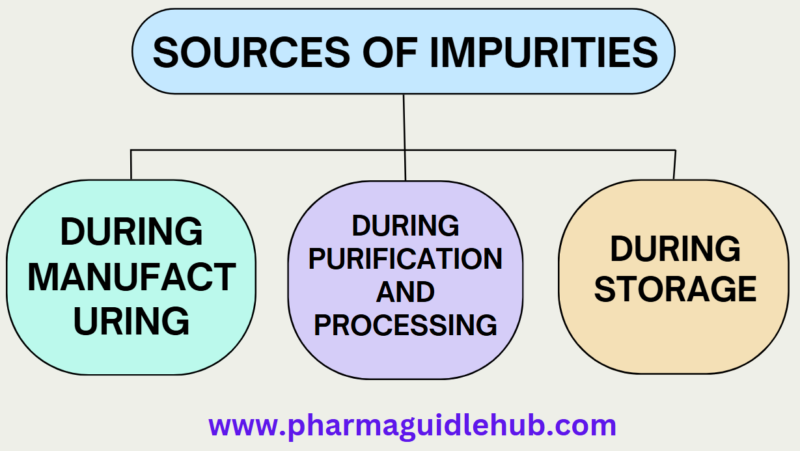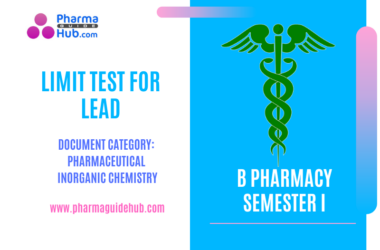Sources of Impurities:
The purpose of drug substances or drug formulations (pharmaceuticals) is primarily for the well-being of humans. They cure patients of diseases, disorders or deficiencies. They cure due to their potency and therapeutic efficacy. However, these properties are also related to another important characteristic; and that is purity. Today a large number of drugs, Chemicals and other substances are used in formulations. Keeping in mind the above fact as well as the prevelant global competition, it is, however, pertinent that pharmaceutical chemicals and formulations must maintain a very high degree of purity. A compound is said to be impure if it has foreign matter/impurities. These impurities affect its potency.
Although, it is almost impossible to attain 100% purity, technically as well as, cost wise, it is still possible to achieve a high degree of purity. Today’s globalisation has increased competitiveness and awareness about quality of drugs and markets demand in general >99% purity.
Purity, though can be achieved through the process of purification, it is many a times economically less viable..
Alternatively, a reasonably acceptable purity can be achieved by controlling various sources or reasons that add to the impure nature of an active pharmaceutical ingredient, or drug as well as excipients used in pharmaceutical formulations. Pharmacopoeias have fixed the limit for these impurities.
Effects of Impurities on Pharmaceuticals:
- Some impurities if present beyond certain tolerance limits can cause untoward side effects that can lead to unpleasant reactions. e.g., Heavy metals like Pb, Fe and As salts.
- Some impurities which are otherwise harmless in nature and without any therapeutic effect, if present in considerable proportions dilute the active strength or potency of the drug substance. e.g. Na, K, Cl, SO4, CO3 salts.
- Some impurities may be able to catalyse the degradation, thereby shortening the shelf life of the drug substance.
- Some impurities by their chemical nature can interact with the drug substance to affect its purity and potency. Such impurities are said to be incompatible with the drug substance/s.
- Some impurities by virtue of their unstable nature like hygroscopic nature, oxidisable nature etc., can bring about change in the physical properties like change in appearance, taste, odour, stability etc., of the drug substance causing technical difficulties in its use as well as formulation.
Impurities may enter or are formed in a drug substance during any of the following three stages:
- During manufacturing.
- During purification and processing.
- During storage.
1. During Manufacturing:
Raw Materials employed :
- Impurities present in raw materials may be carried through the manufacturing process to contaminate the final product. Impurities such as As, Pb, heavy metals, chlorides associated with Na compounds, H2SO4 with CuSO4 and HCI with FeCl3 are some common examples. Likewise many elements accompany others in traces.
Reagents used in manufacturing process:
- The quality and purity of reagents used for manufacturing the drug substances are very important. If reagents used in the manufacturing process contain some impurities these may find entry into the final product. For e.g. Sulphuric acid is used in many chemical processes. This acid often has lead present in it. Anions like Cl– and SO4-2 are common impurities in many substances because of the use of hydrochloric acid and sulphuric acid, respectively, in processing.
Solvents used in the manufacturing process:
- The manufacturing processes may involve a single step or multiple steps (unit operations). Naturally, solvents play an important role next to the main reagents as most of the chemical reactions involved in these processes are solvent based. If proper quality/purity of solvents is not assured, they may add to the impurities. Solvents like toluene, n-butanol contain water as an azeotrope. Alcoholic solvents also may be contaminated with water and ethyl acetate can contain acetic acid in small amounts. Thus, quality of solvents needs to be assured and controlled.
Reaction vessels:
- The reaction vessels employed in the manufacturing process may be metallic (cast iron, mild steel, stainless steel) or mild steel with glass lining. Some solvents and reagents employed in the process may react with the metals of the reaction vessels, leading to their corrosion and passing traces of metal impurities into the solution, contaminating the final product. Similarly, glass vessels may leach traces of alkali into the solvent. Even if acids like HCI if by chance contain a small amount of fluoride, it can itch the glass lining and begin the metallic contamination. Lead, antimony, bismuth, etc. can crop up as impurities from the vessels.
Intermediate products in manufacturing process:
- Some intermediates which are produced during the manufacture may be carried out through the final product as impurities. Intermediates are products of (i) incomplete conversion of reactants to final products or (ii) side or competing reactions or (iii) decomposition of products formed due to poor process control. In the manufacturing process of KI, the intermediate iodate is the main impurity. Similarly, sodium bromate is the impurity in NaBr.
Defects in manufacturing process:
- Defects like imperfect mixing, non-adherence to optimum reaction conditions (proper temperature, pressure and pH) may lead to impurities. E.g., Improper heating (failing to achieve bright red temperatures) in process of manufacture of zinc oxide can lead to un oxidised metallic Zn as an impurity.
2 Zn + O2 ————-> 2 ZnO + Zn (impurity)
Manufacturing hazards:
- In industrial areas, the atmosphere is contaminated with dust particles (Al2O3 , silica glass, carbon, gases like H2S, SO2, CO2, CO etc.). During the manufacture of pharmaceutical products, these impurities may enter the final product. Accidental inclusion of dirt or glass or porcelain or silica or carbon or fibre particles due to poor manufacturing practices and facilities unable to check atmospheric and cross contaminations can lead to unwanted particulate matters in the product in many ways. These need to be checked and controlled. Wear and tear of machineries may shed metallic particles.
2. During Purification and Processing:
Often if not properly controlled, impurities also get added during the purification processes, mainly through the purifying reagents, solvents or vessels used.
Reagents used to remove other impurities:
- Sometimes some chemicals are added to remove or to precipitate another substance. This may be also give rise to source of impurity. For e.g. BaCl3 is added to remove excess of sulphate in AICl3, hence AICl3 is likely to contain Ba as an impurity.
Solvents used in the process of purification:
Often the solvents used for purification can be sources of impurities. These solvents range from organic solvents to acids (organic as well as mineral) and of course water.
Water is the cheapest solvent and most widely used. Therefore it is known as universal solvent.
Types of water used are:
Tap water : It contains impurities of Na+, Ca +2, Mg +2, C03-2 , SO4-2which when used appear as impurities in the final product.
Softened water : It contains Na+and Cl– ions as impurities which when used may appear as impurities in the final product.
Demineralised water: Though it is free from all above inorganic ion- impurities it still contains organic impurities like salts of carboxylic acids, N and S etc.
Distilled water : Considered to be the best. It is pure water and is free from all inorganic and organic impurities but the cost of it’s production is very high.
Contamination due to vessels and equipment used for purification:
During the purification processes, if the vessels are defective or not perfectly cleaned and dried they may add impurities like metallic ions, rust, glass particles, moisture etc.
The other equipment mainly the filters, centrifuges, dryers etc., also need to be clean and dry.
3. During Storage and Packaging:
Errors in the packaging or use of substandard packaging material :
During the process of packaging or filling and sealing , whether applicable for solid dosage forms or liquid dosage forms or API , proper material which can ensure complete foolproof packaging without access to atmosphere and light will ensure the stability of the product. Thus, quality and strength of packaging material is very important.
e.g., If the aluminium foil for tablet strip or cap for a liquid formulation bottle is of substandard quality it can add to impurities. This may lead to recalls of entire batches from the market. This is very critical for parenteral formulations.
Faulty packaging processes :
Most of the pharmaceutical packaging processes are assembly lined automated process, generally involving pressing and sealing with heat. If the process parameters are not optimised or are tampered with, then it may lead to contaminations. e.g., Now a days most of the parenteral products are in polymer containers using FFS (Form-Fill-Seal) processes which involve proper heating, filling, sealing and congealing cylces. Any changes in process parameters can be hazardous.
Microbial contamination:
Microbial contaminations, mainly in the form of fungal and bacterial growth may be due to the result of improper storage conditions as well as faulty packaging. The products for parenteral administration and ophthalmic preparations have to undergo sterility tests.


